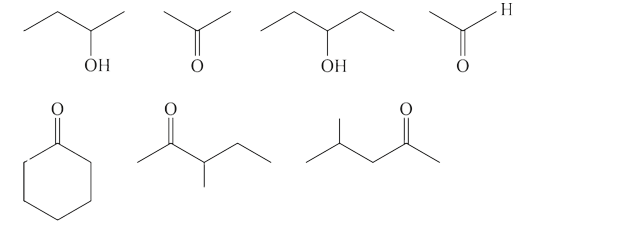Identify the optically active compounds from the following
[Co(en)3]3+
trans−[Co(en)2Cl2]+
cis−[Co(en)2Cl2]+
[Cr(NH3)5Cl]
The correct Answer is:A, C
To identify the optically active compounds from the given options, we will analyze each compound based on its symmetry and the presence of non-superimposable mirror images. Here’s the step-by-step solution:
Step 1: Analyze the First Compound
- Compound: (Co(en)3)³⁺
- Structure: This is a cobalt complex with three bidentate ethylene diamine (en) ligands.
- Symmetry: The arrangement of the ligands in an octahedral geometry does not exhibit any symmetry.
- Optical Activity: Since it lacks a plane of symmetry, it has non-superimposable mirror images, making it optically active.
Step 2: Analyze the Second Compound
- Compound: (Co(en)2Cl2) (trans)
- Structure: This is an octahedral complex with two bidentate ethylene diamine ligands and two trans chlorine ligands.
- Symmetry: The trans arrangement creates a plane of symmetry.
- Optical Activity: Because it has a plane of symmetry, it is optically inactive.
Step 3: Analyze the Third Compound
- Compound: (Co(en)2Cl2) (cis)
- Structure: This is an octahedral complex with two bidentate ethylene diamine ligands and two cis chlorine ligands.
- Symmetry: The cis arrangement does not have a plane of symmetry.
- Optical Activity: It has non-superimposable mirror images, making it optically active.
Step 4: Analyze the Fourth Compound
- Compound: (CrCl(NH3)5)²⁺
- Structure: This is a chromium complex with five ammonia ligands and one chloride ligand.
- Symmetry: The arrangement has a plane of symmetry due to the presence of identical ammonia ligands.
- Optical Activity: Because it has a plane of symmetry, it is optically inactive.
Conclusion
Based on the analysis:
- Optically Active Compounds: First compound (Co(en)3)³⁺ and Third compound (Co(en)2Cl2) (cis).
- Optically Inactive Compounds: Second compound (Co(en)2Cl2) (trans) and Fourth compound (CrCl(NH3)5)²⁺.
Thus, the answer is that the optically active compounds are the first and third options.
---
- Compound: (Co(en)3)³⁺
- Structure: This is a cobalt complex with three bidentate ethylene diamine (en) ligands.
- Symmetry: The arrangement of the ligands in an octahedral geometry does not exhibit any symmetry.
- Optical Activity: Since it lacks a plane of symmetry, it has non-superimposable mirror images, making it optically active.
- Compound: (Co(en)2Cl2) (trans)
- Structure: This is an octahedral complex with two bidentate ethylene diamine ligands and two trans chlorine ligands.
- Symmetry: The trans arrangement creates a plane of symmetry.
- Optical Activity: Because it has a plane of symmetry, it is optically inactive.
- Compound: (Co(en)2Cl2) (cis)
- Structure: This is an octahedral complex with two bidentate ethylene diamine ligands and two cis chlorine ligands.
- Symmetry: The cis arrangement does not have a plane of symmetry.
- Optical Activity: It has non-superimposable mirror images, making it optically active.
- Compound: (CrCl(NH3)5)²⁺
- Structure: This is a chromium complex with five ammonia ligands and one chloride ligand.
- Symmetry: The arrangement has a plane of symmetry due to the presence of identical ammonia ligands.
- Optical Activity: Because it has a plane of symmetry, it is optically inactive.
Based on the analysis:
- Optically Active Compounds: First compound (Co(en)3)³⁺ and Third compound (Co(en)2Cl2) (cis).
- Optically Inactive Compounds: Second compound (Co(en)2Cl2) (trans) and Fourth compound (CrCl(NH3)5)²⁺.
Topper's Solved these Questions
- COORDINATION COMPOUNDSBOOK - NCERT EXEMPLAR ENGLISHCHAPTER - COORDINATION COMPOUNDSEXERCISE - Short Answer Type
12 Videos
- COORDINATION COMPOUNDSBOOK - NCERT EXEMPLAR ENGLISHCHAPTER - COORDINATION COMPOUNDSEXERCISE - Maching The Columns
5 Videos
- COORDINATION COMPOUNDSBOOK - NCERT EXEMPLAR ENGLISHCHAPTER - COORDINATION COMPOUNDSEXERCISE - Long Answer Type Question
5 Videos
- CHEMISTRY IN EVERYDAY LIFEBOOK - NCERT EXEMPLAR ENGLISHCHAPTER - CHEMISTRY IN EVERYDAY LIFEEXERCISE - Long Answer Type Qns
4 Videos
- D AND F-BLOCK ELEMENTSBOOK - NCERT EXEMPLAR ENGLISHCHAPTER - D AND F-BLOCK ELEMENTSEXERCISE - Short Answer Type Question
20 Videos
Similar Questions
Knowledge Check
An optically active compound
Arotates the plane of polarised lightBchanges the direction of polarised lightCdoes not allow plane polarised light to pass throughDnone of these.
Identify the compound that on hydrogenation produces an optically active compound from the following compounds :

View SolutionThe optically active species among the following is:
View SolutionNumber of optically active compounds out of following that can give Haloform reactions.

View SolutionWhich is optically active :-
View SolutionThe formation of an optically active compound from a chiral molecule is called:
View SolutionAn optically active compound A with molecular formula C8H14 undergoes catalytic hydrogenation to give an optically inactive product. Which of the following structures for A is/are consistent with all the data?
View SolutionIdentify the optically active stereoisomer of benzene hexachloride (BHC).
View Solution
